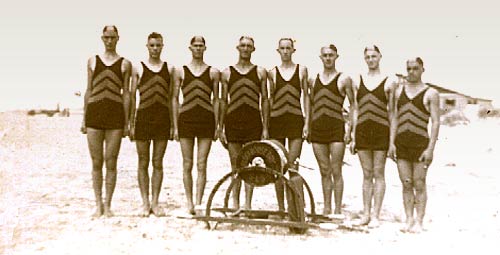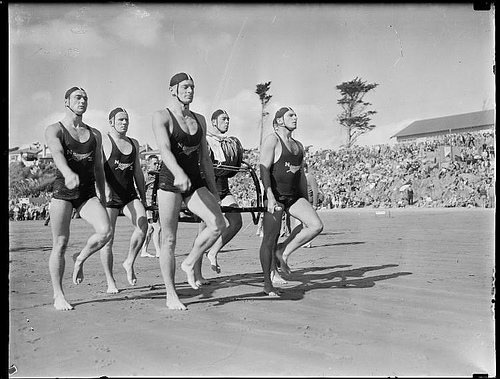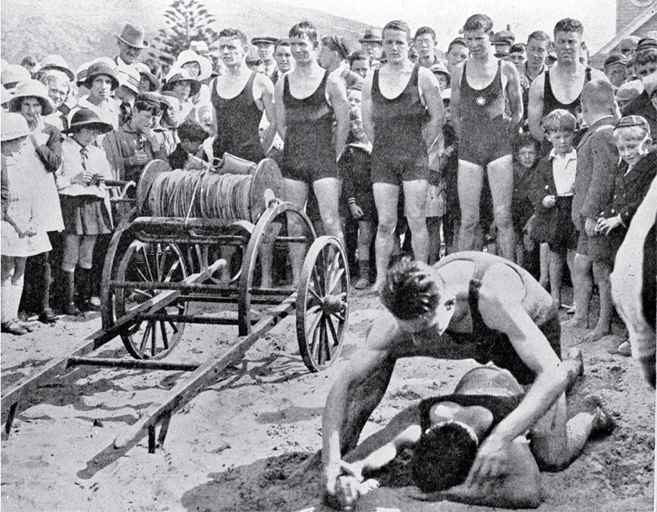Consisting of two elongated main islands New Zealand has thousands of beaches with the majority of Kiwis having easy access to one. Today, there are 74 surf clubs operating in New Zealand.
In the 1920s, swimming became a fad. Unfortunately, most people couldn’t swim so it seemed a good idea to have those who could swim keep an eye out for non swimmers who were drawn to the sea to cool down or relax. The first lifesaving club appeared in Christchurch in 1909 and was quickly followed by the Lyall and Worser Bay clubs in Wellington. The St. Clair Surf Club in Dunedin and the Castlecliff club in Wanganui were also established at this time. By the 1930s, lifesaving clubs were found active on most city beaches over the summer months.
 Lifesaving Team 1930s (blockhousebayhistoricalsociety.com)
Lifesaving Team 1930s (blockhousebayhistoricalsociety.com)
The early clubs copied the Australian model with the same costume and cap design. They also adopted the same competition rules which helped during the popular trans-Tasman festivals. The boys at the Lyall Bay club were particularly impressed with the masculinity of the Australian lifesavers and the club openly recruited members for their looks and body shape as much as their swimming abilities. Rivalry soon developed between the different clubs and the first official surf club competition was held in 1912. This was the year the Titanic sank so the dangers of being in the ocean came into sharp focus and created an awareness of beach lifesaving among the general public.
MALE IMAGE
The 1930s was an image conscious time and the beach was an ideal place to show off male strength and beauty. It was also a decade embracing militaristic activities. This included uniforms and parades so played perfectly into the hands of surf clubs. Frequent beach parades were popular with the public. The lifeguards would march stiffly behind the guy carrying the club’s flag. There was also a straight arm salute during these parades. This was a direct copy of the Nazi salute that was seen in newsreels and oddly appealed to Kiwi sports clubs. (I have seen a photo of the Nazi salute being used by girl guides as they marched along Dunedin’s main street during a parade at that time) It’s not that the nation was pro-fascist. The images of uniformed groups marching with stiff arm salutes looked cool and portrayed solidarity for a cause. Why not adopt the same salute to indicate group solidarity at home too! I am sure this militant salute was quickly dropped when the true nature of the Nazis became apparent.
 Marching Practice (chchuncovered)
Marching Practice (chchuncovered)
The 1930s was a time of mechanical development and the machine became a symbol of modernity and progress. The lifesaver, with his short hair, broad shoulders, muscular legs, tight costume, erect posture, mimicked the machine. These men were machines designed to save those in peril in the sea. Their strength was highly respected by the general public and their marching precision was a source of pride among all those who flocked to New Zealand beaches over the summer months. The surf club costumes and activities were copied by young boys who dreamt of one day joining their local surf club.
UNIFORMS
There were no other opportunities to wear sexy uniforms outside surf clubs. This was another reason surfers were so highly admired at this time. Kiwis were more fascinated by the lifeguard uniform than would be the case in most other countries. This was due to New Zealand being a sporting nation where every team had its own uniform. Lifesavers had different uniforms for their various activities. There was one outfit for surf rescue, another for competitions. A more body hugging uniform would be worn during parades. There were even blazers worn while travelling to competitions.
ANNUAL EVENT
The yearly National Surf Lifesaving Championships was a beach spectacular that attracted massive crowds. It was not unusual for over 10,000 to attend the festivities. Teams from around the country took part in the grand march past. The ‘soldiers of the beach’ transformed the sand into a parade ground where precision marching, huge fluttering club flags and colourful costumes created an atmosphere unique to sporting events in New Zealand.
Demonstrations of surf rescue techniques were also an important part of the competition. Each lifesaving team consisted of 4 men who were usually chosen for their physique and good looks. Acrobatics and feats of strength were side events at these competitions. In other words, at this time, the lifesaving champs were really a celebration of Kiwi masculinity. There was a sexual component to these beach events. Lifesavers were the “peacocks of the sand” and the public flocked to the beach to ogle at their defined bodies.
 Rescue Demonstration 1930s (flickriver.com)
Rescue Demonstration 1930s (flickriver.com)
GOLDEN ERA FOR SURF CLUBS
The 1930s was the golden age for lifesaving in New Zealand. Top lifeguards were treated as national heroes and were household names. Clubs grew in the respect and esteem of the nation as they won national championships. The winners of the top award – the Nelson Shield, returned as heroes to their hometown. They were idolized as today’s rugby stars are.
The Second World War drew the majority of the country’s lifesavers to Europe. To fill the gap, females took over beach patrols and have remained as surf club members ever since.
Today’s lifeguards are a totally different breed from the men of the 1930s. The stiff parades have gone although the competitions remain. Rather than relying on male brawn, technology has taken over with motorized surfboats and buggies widely used. Jet skies and even helicopters are also used in today’s surf rescues. One thing has remained from the early days of surf clubs – volunteers. In the past year, these people who give up their time to help others, completed close to 110,000 lifesaving actions.
Ceidrik Heward





















 Visit Today : 134
Visit Today : 134 Total Visit : 1073953
Total Visit : 1073953